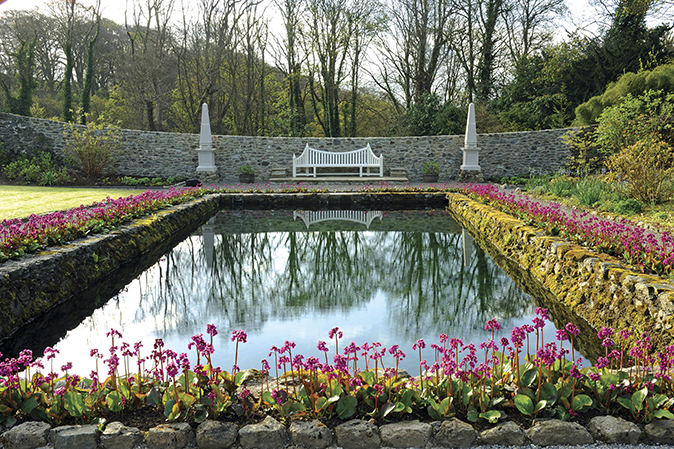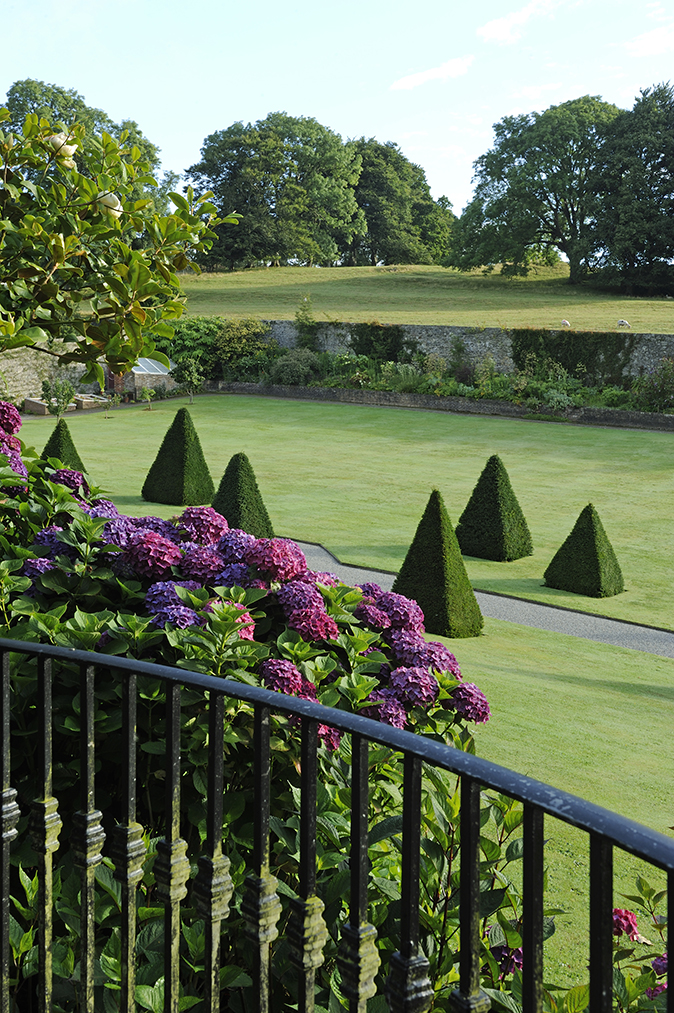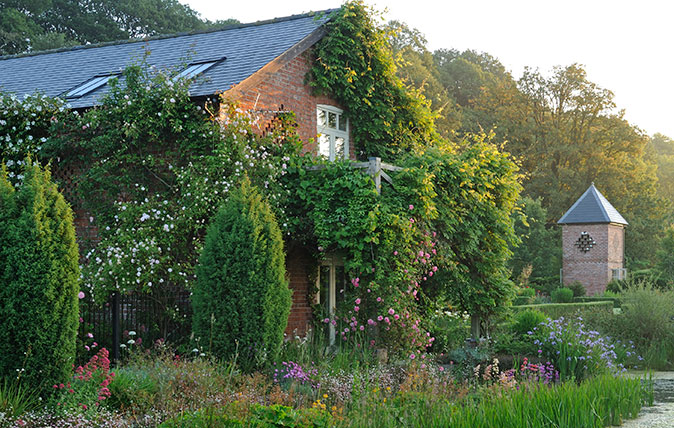Plas Cadnant, Isle of Anglesey: The place where the heart rules
Non Morris is enchanted to learn about the twice-over extraordinary restoration of an Anglesey garden by its owner, who ‘fell for its romantic charm.’


As Anthony Tavernor explains: ‘Sometimes, you follow your heart, not your head.’ We are about to explore the gardens at Plas Cadnant, just across the Menai Suspension Bridge that connects Anglesey to the North Wales mainland. He’s keen to give a sense of the journey he’s made from buying the near-derelict property in 1996 to creating the extraordinarily beautiful and atmospheric gardens you can visit today. ‘I just fell in love with the whole thing. I had no connections with Anglesey. It’s not an outstanding house. I simply landed here out of the blue and fell for its romantic charm.’
The garden had been more or less abandoned for 70 years. You needed a chainsaw to make your way across the walled garden—let alone the wooded valley leading down to the River Cadnant – and the tennis court installed in the 1930s in the garden’s genteel heyday had become a small wood.
For Anthony, a farmer from Staffordshire and a passionate, practical man with a longstanding love of gardens (he’s proud to recall that he became a life member of the National Trust when he was a teenager), spotting the property in Country Life was a chance to bring something beautiful back to life. After a 20-minute viewing of the house and a rough attempt to work out what might remain as garden, he made an offer and has never looked back.

His approach to uncovering the ‘hidden gardens’ at Plas Cadnant has been tireless from the start. While restoring the outbuildings and offering them as holiday cottages to ensure an income source for the garden, he pieced together the history of the property from photographs, old Ordnance Survey maps and any available documentation.
The house had been built in 1803 as a comfortable residence for John Price, Sheriff of Anglesey and agent to the Marquis of Anglesey, whose seat, Plas Newydd, is only four miles away. The two-acre walled garden probably dates from the same period, but there remains the fascinating notion that it may perhaps belong to a much earlier incarnation of the estate.
We are at the entrance to the Walled Garden, which is now an immaculate swooping basin of lawn with a central avenue of clipped yew pyramids casting rhythmic shadows onto velvety turf. The yews lead down to a rectangular pond edged with Gertrude Jekyll-inspired Bergenia Overture and, behind the pool, the distinctive curve of the garden wall is echoed by the curve of a specially commissioned white bench. A towering, much wilder, woodland – the beginning of the Valley Garden – is temptingly visible on the other side of the wall and, beyond the woodland, the craggy Carnedd Hills of Snowdonia.

At the top of the Walled Garden, there is a small productive area—a respectful nod to its former life as a kitchen garden. There are apple-tree cordons (the Bardsey Apple from nearby Bardsey Island and Anglesey Pig’s Snout) and sweet peas for the holiday cottages. The two main themes of the garden are established here: the pyramid shape of the yews to reflect the inspirational influence of Humphry Repton, who worked at Plas Newydd, and the ‘catenary curve’ (used to shape the lower wall of the garden), which is a shape that a chain naturally forms when suspended between two points and is integral to the design of the Menai Suspension Bridge built by Thomas Telford in 1826.
Sign up for the Country Life Newsletter
Exquisite houses, the beauty of Nature, and how to get the most from your life, straight to your inbox.
To the west of the garden – leading out from Garden Cottage – is a double herbaceous border, cleverly and subtly built up from the steep slope (‘it was so steep that it was dangerous, the mower would just slide’). The catenary curve is taken up again in the shape of the yew buttresses that frame the beds and the deep borders that ‘have an Edwardian flavour’, with a colour theme that starts with blue and yellow and slowly changes to reds and crimsons.
With characteristic thoroughness and botanist Philip Brown at his side, Anthony spent a year researching the finest herbaceous borders, from Powis Castle to Chatsworth, before making his plant selection. He’s tenderly aware of the contribution every plant makes: from rarefied treasures such as the tropical-looking Aralias from nearby Crûg Farm, to the exhilarating autumn crimson of dwarf Aruncus (A. aethusifolius).

A copper planter (an echo of the copper mines that had been so important locally) simply filled with Acanthus mollis Rue Ledan draws the eye to a grotto in which the Grecian river god, Alpheus, nestles in a stone pyramid above a circular pool. The pool is ingeniously constructed from reclaimed kerb stones and the surrounding border is planted with covetable ferns such as Dryopteris affinis Cristata and the lovely blue-backed anemone Wild Swan.
A raised border on the opposite side of the garden is designed to look good from a distance. Massed plantings of tulips for late spring – the dazzling Gudoshnik and the scarlet Appledoorn – are followed by towering Echium pininana and richly coloured Agapanthus.
From the grotto, a dramatically dark tunnel of yew leads to the Valley Gardens, where the magic really begins. The restoration and subtle development of this area is a triumph. It had been enjoyed in the 19th century for its picturesque qualities – rocky outcrops, belvederes, waterfalls and ancient trees – but, by 1996, was ‘solid with cherry laurel and ponticum’.

Now, the Valley Gardens offer an intriguing journey through rare ferns – the muscly Blechnum chilense becomes satisfyingly huge as the moisture increases – extraordinary moss-covered tree roots and everywhere the self-seeding Geranium canariensis, which promises a delicate blaze of deep pink next spring. In this very moist microclimate, incredible plants grow like crazy.
There are staggering individual specimens everywhere and a margarine tub of tiny Acer morifolium seedlings from Crûg Farm has become a lovely grove of snake-bark maples on either side of the serpentine path, the dancing chainmail of their lime-green leaves forming a gorgeous uplifting roof as they catch the light.
There are enormous paddle-like leaves of a particularly fine form of Hydrangea aspera subsp. sargentiana, a restrained waterfall spilling out from a groove cut into a stone gate post laid horizontally, a glassy reflecting pool where there was once an unkempt boggy area and a Gothic archway that Anthony couldn’t resist creating from hazel poles (‘I’m a member of The Folly Fellowship,’ he explains) over which he’s training Styrax japonicus, the Japanese Snowbell tree.

In spring, after sheets of snowdrops and bluebells, the green is electrified by the clear purple of Rhododendron Saint Tudy and the unfolding elegance of choice magnolias.
We return via the Upper Valley Garden, an area that had to be restored for a second time after the devastating ‘Boxing Day Flood’ of 2015, when water rampaged down the centre of the Walled Garden and burst through the lower wall, sweeping away huge quantities of stone and plants. Eighteen months later, this sheltered area was looking immaculate once more and almost tropical.
The wall has been redesigned with openings to relieve potential water pressure and Anthony is free again to enjoy his favourite plants and perhaps add just a few more. He points out Rhododendron pachysanthum, which has such alluring bronzy indumentum on the leaves that visitors reach out to touch them and sometimes even scratch out their initials. He also introduces me to the rare and beautiful Disanthus cercidifolius, a shrub with heart-shaped leaves offering incredible copper, gold and red autumn colour: ‘If I ever moved and had another garden, I would make sure I had one of these.’

The idea that Anthony would even consider making a new garden is extraordinary. The hidden gardens at Plas Cadnant reveal a humbling, hands-on, imaginative and celebratory journey of the man who has brought them back to life. They are a joy to visit.
Plas Cadnant, Cadnant Road, Menai Bridge, Isle of Anglesey (01248 717174; www.plascadnant.co.uk).
In 2018, the Hidden Gardens and Tea Room will be open from April to October – visit the website for details and for additional opening times. Horticultural tours available by arrangement. There are also five restored holiday cottages to rent within the gardens.

Blackdykes: A romantic, uplifting and inspiring garden by the sea
Blackdykes, in North Berwick, is on a plot barely a mile from the sea that took a huge amount of

Rhodds Farm: From open space to stunning country garden in under 12 years
Richard and Cary Goode have carried off something almost miraculous at this lovely spot in Herefordshire – and they've done it

Credit: Hutton-in-the-Forest - Country Life / Val Corbett
Hutton-in-the-Forest's glorious gardens: From muddle to lightness and calm
Country Life is unlike any other magazine: the only glossy weekly on the newsstand and the only magazine that has been guest-edited by HRH The King not once, but twice. It is a celebration of modern rural life and all its diverse joys and pleasures — that was first published in Queen Victoria's Diamond Jubilee year. Our eclectic mixture of witty and informative content — from the most up-to-date property news and commentary and a coveted glimpse inside some of the UK's best houses and gardens, to gardening, the arts and interior design, written by experts in their field — still cannot be found in print or online, anywhere else.
-
 Two quick and easy seasonal asparagus recipes to try this Easter Weekend
Two quick and easy seasonal asparagus recipes to try this Easter WeekendAsparagus has royal roots — it was once a favourite of Madame de Pompadour.
By Melanie Johnson
-
 Sip tea and laugh at your neighbours in this seaside Norfolk home with a watchtower
Sip tea and laugh at your neighbours in this seaside Norfolk home with a watchtowerOn Cliff Hill in Gorleston, one home is taller than all the others. It could be yours.
By James Fisher